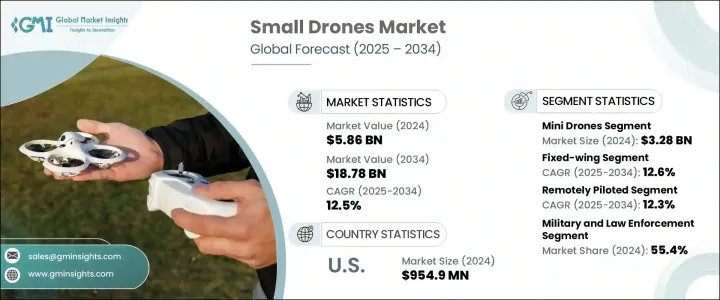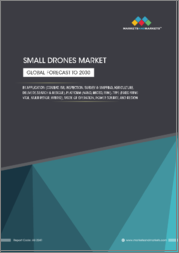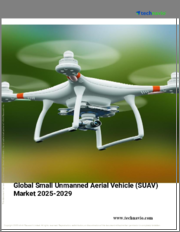
|
시장보고서
상품코드
1755365
세계의 소형 드론 시장 : 기회, 성장 촉진요인, 산업 동향 분석 및 예측(2025-2034년)Small Drones Market Opportunity, Growth Drivers, Industry Trend Analysis, and Forecast 2025 - 2034 |
||||||
세계의 소형 드론 시장 규모는 2024년에 58억 6,000만 달러로 평가되었고, 배터리 에너지 밀도, 센서의 소형화, 온보드 데이터 처리 등의 주요 분야에 있어서의 진보에 의해 2034년에는 187억 8,000만 달러에 달할 것으로 예측되며, CAGR 12.5%로 성장할 전망입니다.
이러한 발전으로 소형 드론은 더욱 효율적이고 가벼워지며 지능화되어 다양한 분야에서 폭넓게 사용될 수 있게 되었습니다. 인공 지능과 기계 학습의 통합은 배포를 더욱 가속화하여 사람의 개입 없이 자율적인 의사 결정, 장애물 회피 및 적응형 임무 계획을 가능하게 합니다.

빠른 혁신이 확장을 촉진하는 한편, 글로벌 무역 관세의 초기 영향은 일시적인 어려움을 야기했습니다. 철강, 알루미늄 및 특정 전자 부품과 같은 자재에 대한 관세는 제조 비용을 상승시켜 글로벌 공급망을 혼란에 빠뜨렸습니다. 이러한 침체는 특히 비용에 민감한 국방 프로그램에서 두드러지게 나타났습니다. 그러나 이러한 압력은 여러 국가가 핵심 드론 부품의 국내 제조 역량을 강화하고 자급자족 전략에 투자하도록 촉진했습니다. 시간이 지나면 이 전환은 수입 의존도를 줄이고 혁신을 촉진할 것으로 예상됩니다. 관세는 초기에는 가격 인상과 배포 지연을 초래했지만, 소형 드론 생태계에서 리쇼어링과 현지 생산 확대를 통해 장기적인 혜택을 가져올 것으로 예상됩니다.
| 시장 범위 | |
|---|---|
| 시작 연도 | 2024년 |
| 예측 연도 | 2025년-2034년 |
| 시작 금액 | 58억 6,000만 달러 |
| 예측 금액 | 187억 8,000만 달러 |
| CAGR | 12.5% |
미니 드론 분야는 방위 및 민생 부문에 널리 채용되고 있기 때문에 2024년 시장 규모는 32억 8,000만 달러였습니다. 이 드론은 감시, 정보 수집, 정찰 임무와 같은 전술적 작전에 필수적인 요소가 되었습니다. 다양한 페이로드 지원을 유지하면서 효율적인 성능을 발휘하는 유연성은 군사 분야에서 강력한 경쟁 우위를 제공합니다. 상업 분야에서는 항공 검사, 지도 제작, 사진 촬영, 인프라 조사 등에 널리 활용되며 시장 지배력을 더욱 공고히 하고 있습니다.
고정익 드론은 2034년까지 12.6%의 CAGR을 기록할 것으로 예상됩니다. 탑재 하중이 제한적이지만, 이 부문은 내구성과 장거리 작전에 적합하기 때문에 계속 성장하고 있습니다. 이 드론은 고고도 및 저고도 임무에 이상적이며 ISR 역할에서 강력한 성능을 발휘합니다. 센서 기능 개선 및 원격 작동 기능 등 기술의 발전이 채택을 촉진하고 있습니다. 특히 국방 분야에서 BVLOS(시야를 넘어선 비행)에 대한 요구가 증가하면서 고정익 드론 부문이 발전하고 있습니다.
미국의 소형 드론 2024년 시장 규모는 9억 5,490만 달러로 평가되었습니다. 미국은 국방부의 꾸준한 자금 지원과 주요 민간 기업들의 투자를 바탕으로 전 세계에서 선도적인 위치를 유지하고 있습니다. 무인 시스템의 상당한 발전, 예를 들어 무리 기술 및 자율 ISR 임무는 국방 기관과 신생 기업 간의 협력을 통해 추진되고 있습니다. 무인 표면 및 수중 플랫폼에 중점을 둔 미국은 국내 혁신과 AI 통합에 크게 의존하여 드론 기반 운영에서 입지를 계속 확대하고 있습니다.
세계의 소형 드론 시장의 주요 기업은 DJI Technology, Lockheed Martin, Northrop Grumman, Teledyne Technologies 및 AeroVironment가 있습니다. 소형 드론 부문에서 활동하는 기업들은 제품 혁신, 자율 시스템 개발, 소프트웨어 통합을 우선으로 하고 있습니다. 기업들은 향상된 내구성, 모듈식 탑재 하중 지원, 실시간 데이터 처리 기능을 갖춘 드론으로 포트폴리오를 빠르게 확장하고 있습니다. 국방 기관 및 기술 혁신 기업들과의 전략적 파트너십은 무리 조정 및 AI 기반 비행 시스템의 획기적인 발전을 촉진하고 있습니다. 제조업체들은 또한 규제 기준을 충족하면서 민간용으로 비용 효율적인 모델을 개발하여 새로운 시장에 진출하고 있습니다.
목차
제1장 조사 방법과 범위
제2장 주요 요약
제3장 업계 인사이트
- 생태계 분석
- 트럼프 정권의 관세 분석
- 무역에 미치는 영향
- 무역량의 혼란
- 보복 조치
- 업계에 미치는 영향
- 공급측의 영향(구성요소)
- 가격 변동
- 공급망 재구성
- 생산 비용에 미치는 영향
- 수요측의 영향
- 최종 시장에의 가격 전달
- 시장 점유율 동향
- 최종 사용자의 반응 패턴
- 공급측의 영향(구성요소)
- 영향을 받는 주요 기업
- 전략적인 업계 대응
- 공급망 재구성
- 가격 설정 및 제품 전략
- 정책관여
- 전망과 향후 검토 사항
- 무역에 미치는 영향
- 업계에 미치는 영향요인
- 성장 촉진요인
- 배터리 기술의 발전
- 센서와 페이로드의 소형화
- BVLOS 운영에 대한 규제 발전
- AI 기반 분석과의 통합
- 업계의 잠재적 위험 및 과제
- 항공 공간 혼잡 및 주파수 제한
- 데이터 보안 및 개인정보 보호에 대한 우려
- 성장 촉진요인
- 성장 가능성 분석
- 규제 상황
- 기술의 상황
- 장래 시장 동향
- 갭 분석
- Porter's Five Forces 분석
- PESTEL 분석
제4장 경쟁 구도
- 소개
- 기업의 시장 점유율 분석
- 주요 시장 기업의 경쟁 분석
- 경쟁 포지셔닝 매트릭스
- 전략 대시보드
제5장 시장 추계 및 예측 : 유형별(2021-2034년)
- 주요 동향
- 미니 드론
- 나노 드론
- 마이크로 드론
제6장 시장 추계 및 예측 : 플랫폼별(2021-2034년)
- 주요 동향
- 고정익
- CTOL
- VTOL
- 회전익
- 단일 로터
- 다중 로터
- 하이브리드
제7장 시장 추계 및 예측 : 동작 모드별(2021-2034년)
- 주요 동향
- 원격 조종
- 부분 자율
- 완전 자율
제8장 시장 추계 및 예측 : 용도별(2021-2034년)
- 주요 동향
- 군와 법 집행 기관
- 민간 및 상업
제9장 시장 추계 및 예측 : 지역별(2021-2034년)
- 주요 동향
- 북미
- 미국
- 캐나다
- 유럽
- 독일
- 영국
- 프랑스
- 스페인
- 이탈리아
- 네덜란드
- 아시아태평양
- 중국
- 인도
- 일본
- 한국
- 호주 및 뉴질랜드
- 라틴아메리카
- 브라질
- 멕시코
- 아르헨티나
- 중동 및 아프리카
- 사우디아라비아
- 남아프리카
- 아랍에미리트(UAE)
제10장 기업 프로파일
- Aerovironment Inc.
- Autel Robotics
- Delair
- Elbit Systems Ltd
- Israel Aerospace Industries
- Lockheed Martin Corporation
- Microdrones GmbH
- Northrop Grumman
- Raytheon Technologies Corporation
- SZ DJI Technology Co. Ltd.
- Teledyne FLIR LLC
- Textron Inc.
- Thales Group
The Global Small Drones Market was valued at USD 5.86 billion in 2024 and is estimated to grow at a CAGR of 12.5% to reach USD 18.78 billion by 2034, driven by advancements in key areas such as battery energy density, sensor miniaturization, and onboard data processing. These developments make small drones more efficient, lightweight, and intelligent, enabling broader usage across sectors. Integrating artificial intelligence and machine learning has further accelerated deployment, allowing for autonomous decision-making, obstacle avoidance, and adaptive mission planning without human intervention.

While rapid innovation is fueling expansion, the initial impact of global trade tariffs has posed temporary challenges. Tariffs on materials like steel, aluminum, and certain electronic components contributed to higher manufacturing costs, disrupting global supply chains. This slowdown was especially evident in cost-sensitive defense programs. However, these pressures have motivated several countries to strengthen domestic manufacturing capabilities and invest in self-reliance strategies for critical drone components. Over time, this shift is expected to reduce dependency on imports and promote innovation. Although the tariffs initially led to price hikes and deployment delays, they've also opened long-term benefits through reshoring and local production boosts in the small drone ecosystem.
| Market Scope | |
|---|---|
| Start Year | 2024 |
| Forecast Year | 2025-2034 |
| Start Value | $5.86 Billion |
| Forecast Value | $18.78 Billion |
| CAGR | 12.5% |
The mini drones segment held a market value of USD 3.28 billion in 2024, owing to its widespread adoption across defense and civilian sectors. These drones have become vital for tactical operations such as surveillance, intelligence gathering, and reconnaissance missions. Their flexibility in supporting diverse payloads while maintaining efficient performance gives them a strong competitive edge in military use. On the commercial side, mini drones are commonly deployed for applications like aerial inspections, mapping, photography, and infrastructure surveys, further solidifying their dominance in the market.
Fixed-wing drones are expected to register a CAGR of 12.6% through 2034. Despite carrying limited payloads, this segment continues to rise due to its endurance and suitability for long-distance operations. These drones are ideal for high and low-altitude missions, with strong performance in ISR roles. Technological enhancements, including improved sensor capabilities and remote operation features, contribute to their increasing adoption. The growing requirement for beyond visual line of sight (BVLOS) operations, particularly in defense, propel the fixed-wing drone segment forward.
United States Small Drones Market generated USD 954.9 million in 2024. The country maintains a leading role globally, backed by steady funding from the Department of Defense and investments by key private sector players. Significant advancements in unmanned systems, including swarm technology and autonomous ISR missions, are being pushed forward through collaborations between defense agencies and startups. With a focus on unmanned surface and subsurface platforms, the U.S. continues to expand its footprint in drone-enabled operations, relying heavily on domestic innovation and AI integration.
Key players in the Global Small Drones Market include DJI Technology, Lockheed Martin, Northrop Grumman, Teledyne Technologies, and AeroVironment. Companies operating in the small drones segment prioritize product innovation, autonomous system development, and software integration. Firms are rapidly expanding their portfolios with drones that offer enhanced endurance, modular payload support, and real-time data processing capabilities. Strategic partnerships with defense agencies and tech innovators drive breakthroughs in swarm coordination and AI-powered flight systems. Manufacturers are also entering new markets by developing cost-effective models for civil use, while simultaneously meeting regulatory standards.
Table of Contents
Chapter 1 Methodology and Scope
- 1.1 Market scope and definitions
- 1.2 Research design
- 1.2.1 Research approach
- 1.2.2 Data collection methods
- 1.3 Base estimates and calculations
- 1.3.1 Base year calculation
- 1.3.2 Key trends for market estimation
- 1.4 Forecast model
- 1.5 Primary research and validation
- 1.5.1 Primary sources
- 1.5.2 Data mining sources
Chapter 2 Executive Summary
- 2.1 Industry 3600 synopsis
Chapter 3 Industry Insights
- 3.1 Industry ecosystem analysis
- 3.2 Trump administration tariffs analysis
- 3.2.1 Impact on trade
- 3.2.1.1 Trade volume disruptions
- 3.2.1.2 Retaliatory measures
- 3.2.1.3 Impact on the industry
- 3.2.1.3.1 Supply-side impact (components)
- 3.2.1.3.1.1 Price volatility
- 3.2.1.3.1.2 Supply chain restructuring
- 3.2.1.3.1.3 Production cost implications
- 3.2.1.3.2 Demand-side impact
- 3.2.1.3.2.1 Price transmission to end markets
- 3.2.1.3.2.2 Market share dynamics
- 3.2.1.3.2.3 End user response patterns
- 3.2.1.3.1 Supply-side impact (components)
- 3.2.1.4 Key companies impacted
- 3.2.1.5 Strategic industry responses
- 3.2.1.5.1 Supply chain reconfiguration
- 3.2.1.5.2 Pricing and product strategies
- 3.2.1.5.3 Policy engagement
- 3.2.1.6 Outlook and future considerations
- 3.2.1 Impact on trade
- 3.3 Industry impact forces
- 3.3.1 Growth drivers
- 3.3.1.1 Advancements in battery technology
- 3.3.1.2 Miniaturization of sensors and payloads
- 3.3.1.3 Regulatory evolution for BVLOS operations
- 3.3.1.4 Integration with AI-driven analytics
- 3.3.2 Industry pitfalls and challenges
- 3.3.2.1 Airspace congestion and spectrum limitations
- 3.3.2.2 Data security and privacy concerns
- 3.3.1 Growth drivers
- 3.4 Growth potential analysis
- 3.5 Regulatory landscape
- 3.6 Technology landscape
- 3.7 Future market trends
- 3.8 Gap analysis
- 3.9 Porter's analysis
- 3.10 PESTEL analysis
Chapter 4 Competitive Landscape, 2024
- 4.1 Introduction
- 4.2 Company market share analysis
- 4.3 Competitive analysis of major market players
- 4.4 Competitive positioning matrix
- 4.5 Strategy dashboard
Chapter 5 Market Estimates & Forecast, By Type, 2021-2034 (USD Billion & Units)
- 5.1 Key trends
- 5.2 Mini drones
- 5.3 Nano drones
- 5.4 Micro drones
Chapter 6 Market Estimates & Forecast, By Platform, 2021-2034 (USD Billion & Units)
- 6.1 Key trends
- 6.2 Fixed-wing
- 6.2.1 CTOL
- 6.2.2 VTOL
- 6.3 Rotary
- 6.3.1 Single rotor
- 6.3.2 Multi-rotor
- 6.4 Hybrid
Chapter 7 Market Estimates & Forecast, By Mode of Operation, 2021-2034 (USD Billion & Units)
- 7.1 Key trends
- 7.2 Remotely piloted
- 7.3 Partially autonomous
- 7.4 Fully autonomous
Chapter 8 Market Estimates & Forecast, By Application, 2021-2034 (USD Billion & Units)
- 8.1 Key trends
- 8.2 Military and law enforcement
- 8.3 Civil and commercial
Chapter 9 Market Estimates and Forecast, By Region, 2021 – 2034 (USD Billion & Units)
- 9.1 Key trends
- 9.2 North America
- 9.2.1 U.S.
- 9.2.2 Canada
- 9.3 Europe
- 9.3.1 Germany
- 9.3.2 UK
- 9.3.3 France
- 9.3.4 Spain
- 9.3.5 Italy
- 9.3.6 Netherlands
- 9.4 Asia Pacific
- 9.4.1 China
- 9.4.2 India
- 9.4.3 Japan
- 9.4.4 South Korea
- 9.4.5 ANZ
- 9.5 Latin America
- 9.5.1 Brazil
- 9.5.2 Mexico
- 9.5.3 Argentina
- 9.6 Middle East and Africa
- 9.6.1 Saudi Arabia
- 9.6.2 South Africa
- 9.6.3 UAE
Chapter 10 Company Profiles
- 10.1 Aerovironment Inc.
- 10.2 Autel Robotics
- 10.3 Delair
- 10.4 Elbit Systems Ltd
- 10.5 Israel Aerospace Industries
- 10.6 Lockheed Martin Corporation
- 10.7 Microdrones GmbH
- 10.8 Northrop Grumman
- 10.9 Raytheon Technologies Corporation
- 10.10 SZ DJI Technology Co. Ltd.
- 10.11 Teledyne FLIR LLC
- 10.12 Textron Inc.
- 10.13 Thales Group



















